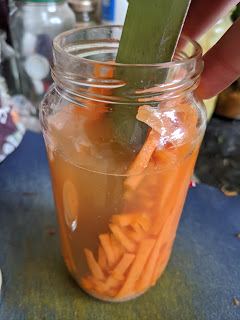It's interesting what people will stockpile in a crisis: toilet paper and pasta, yes; mushrooms, no. Completely understandable of course. Mushrooms aren't known for their shelf life. Still, if you get a little creative, more or less anything edible can be preserved and hoarded for much later consumption.
So it is that if you happen upon supermarket at the right time and at the end of the right socially distanced queue, you can nab yourself some interesting bargains, even in these times of scarcity. In Tesco on Sunday, oyster mushrooms normally retailing at a pricey £1.50 a punnet were going for 38p each. I grabbed three. Which is the maximum amount of anything you're allowed to grab at the moment, but try telling that to the man in front of me insisting to the frustrated checkout hero that 12 bottles of beer (in packs of four each) counted as three items. Fascists. Or maybe communists. Who knows anymore?
 |
| Meanwhile, in the free world... |
So anyway, I thought I'd have a go at drying out my "haul" to add to my now quite expansive collection of things in jars. This was the result:
A success. It was easier than I expected. The trick, I discovered, is to start them off in the oven, sliced and placed onto a sheet of tinfoil, on a low heat (well below 100 C) with the door open for about 10 - 15 minutes. This removes most of the moisture. Then just let them sit on the tinfoil in a sunny spot indoors for about three days. Job done.
It's getting exciting now. Do you know why? Because wild garlic season is almost upon us. See, life isn't all bad. Stay happy!




Related posts
Resilient Vegetable Snacks
Making Horseradish Sauce
More Fun With Food in Jars
Fruits of the Forage
A Soup Made of Scraps
Please consider disabling your adblockers when reading this site. I make every effort to ensure no inappropriate, rubbish or offensive advertising appears here, and nothing that is contrary to the spirit of this blog. So it's really nothing to be afraid of. Cheers.




